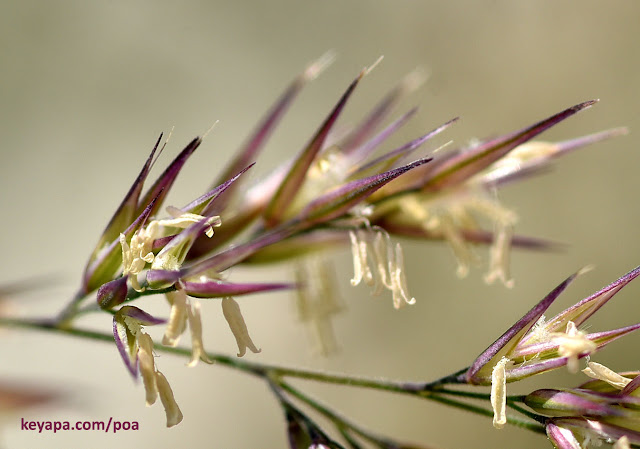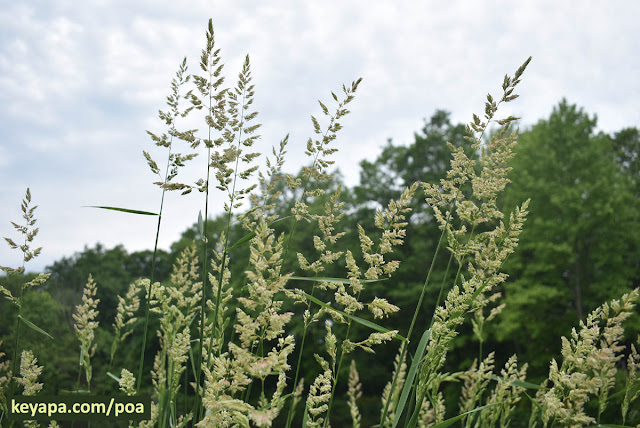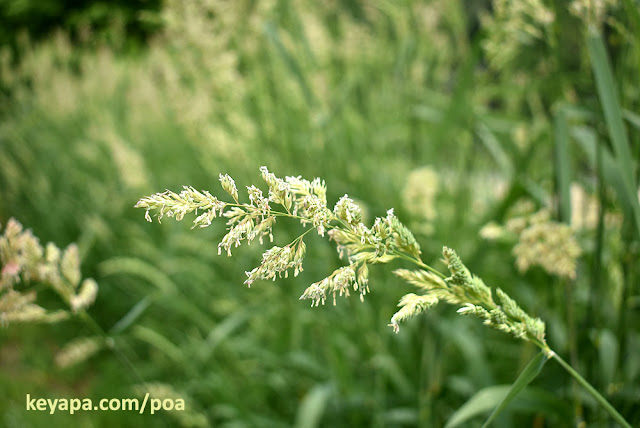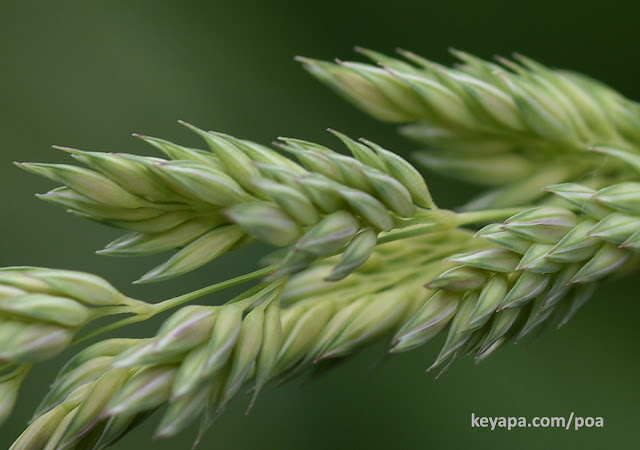Tuesday, June 30, 2020
A broad-leaved forest grass that flowers twice
Nowadays, when I hike among the shaded tree-lined paths of some park in New Jersey, i invariably encounter Microstegium vimineum as it grows in luxuriant carpets along the sides of the trail and into the deeper canopy.
This was at first the case last Thursday, when we went exploring in the Watchung Reservation, and I resigned myself to photographing more of the invasive grass.
Thus it was a pleasant surprise when I spotted an interesting grass nestled in the shady base of one of the trees. It had much larger leaves than stiltgrass, and it also had airy panicles that ended in tiny spikelets. The blades also had distinctive cordate bases, and were quite wide.
I managed to identify the species as Dichanthelium clandestinum, one of the rosette panic grasses.
This species lives in forests, and has an unusual flowering behavior.
Near the beginning of the season, it produces "normal" flowers which are pollinated when open ("chasmogamous"). Then later in the season, the same individual has closed flowers hidden in the sheaths that will be self-pollinated ("cleistogamous").
The evolutionary advantage of cleistogamy is that the grass does not need to expend a lot of energy into the production of flower accessory structures, and this mode of flowering seems to prevalent in some plants when they are stressed. However, its disadvantage is that it dampens genetic diversity in the population due to self-fertilization.
It was quite nice to find such a new species, and I'll be sure to keep my eyes open for more grasses from the genus Dichanthelium is future hikes.
Sunday, June 28, 2020
A Tale of Three Salt Marsh Grasses
The salt marsh environment is interesting because it is composed of several layered environments, each of which have their corresponding population of species. The low marsh is closer to the sea, and is inundated daily by the rising tide, whereas the high marsh is only flooded during times of exceptionally high tides.
I have noted the ubiquity of Phragmites australis in Cheesequake State Park in earlier posts, but two other grass species are present in force, especially around the crabbing bridge that is one of the main attractions of the park.
 |
| S. patens in front of P. australis. Individuals of the latter shoot up in the midst of S. patens. |
 |
| S. alterniflora along the water edges |
 |
| P. australis lines the edges of lakes and ponds in the park |
P. australis of course has been deemed the villain in this tale. It is the invasive, and it supplants the native salt marsh plants in its relentless march towards dominance, forming extensive monocultures of 4 meter tall grasses. Its dominance then causes changes in both the biotic and abiotic environment around it.
For example, because of its faster growth rate and investment in below ground structures, the dense mats of decaying organic matter that accumulate in tidal marches dominated by P. australis actually elevate the wetland surface. The very dense stands of this species also slow the movement of tidal water, such that flooding is less deep and less prolonged.
 |
| P. australis blocks view of a pond |
 |
| P. australis looms behind a wading egret |
So the next time you see dense stands of P. australis hogging a shoreline, don't immediately despair over the fate of that environment. Things may be more complicated than a simple black and white perspective on such invasives.
Thursday, June 11, 2020
Alien spaceships: The rad spikelets of Calamagrostis acutiflora
One of the most productive and vigorous ornamentals I have is what I take to be a cultivar of Calamagrostis acutiflora, most probably 'Karl Foerster'.
This grass is a strong performer in my home, and I have had to divide it every Spring due to its vigorous growth.
I know some people love it, and it does make a good specimen, but I was never impressed by its inflorescence, even when dried...until I took macro shots of it.
When I noticed that one of the larger specimens was flowering, I decided I'd take the time to see what the spikelets looked like close up, and I have to admit I was kinda impressed by them.
The glumes glistened with various shades of purple violet, and their sharp stream-lined shapes reminded me of deadly fighters in space. It was an altogether surprising find, especially when contrasted with the somewhat dull brownish color of the entire inflorescence when seen with the naked eye.
Unfortunately, the effect was somewhat ruined once anthesis arrived, and the white anthers drooped from the spikelets. Unlike in some other grasses that I've seen, the overall effect of the whitish stamens and stigmas draped against the hard-looking glumes was one of disorder.
In Calamagrostis, each spikelet contains a single floret, and in some of the shots I took it was easy to see the feather-like stigma poking out below the much longer anthers on their long white filaments (see below).
Wednesday, June 10, 2020
Does Stephen King have a Hate-Hate Relationship with the Poaceae?
WARNING: Spoilers below!!!
I am a serious Stephen King fan.
I remember reading some of his classics like Firestarter, Carrie, The Dead Zone, and Pet Sematary when I was in my early teens, and I even made the usual pilgrimage of King fans by going to Maine and seeing some of the iconic spots that somehow made it into his books. We even have the same political leanings, and I love how he uses his pulpit to try to right wrongs in the real world.
However, after finishing his new story In the Tall Grass, I have to wonder whether he has a hidden aversion to anything involving grasses. Some of his work features examples of this plant family (Poaceae) as major parts of the story, and in almost all cases they are used as ominous and terrible omens, settings, and even actual antagonists in the plot.
 |
| Who dares enter this field of tall Phragmites australis grass? |
The use of tall fields of grasses as an ominous symbol is also very much in evidence in another short story, the classic Children of the Corn. In this case, the fields of corn not only provide a dark setting for the story, but it also hides the demonic He Who Walks Behind the Rows.
Finally, a somewhat mundane suburban lawn becomes the setting for another King short story, The Lawnmower Man. In this case, a "field" of turfgrass grows wild when a homeowner fails to do his weekly mowing, and his call to a professional mowing company brings to his home another demon whose appetite for grass knows no bounds.
 |
| A dimly-lit bamboo grove likely hides evil demonic beings, or at least it might in Stephen King's stories |
In the novel, rice forms an integral part of the town's culture. For example, it figures prominently in their dance, as when the protagonist Ronald dances and sings The Commala, which asks Lady Oriza to bless the rice and is in celebration of the harvest season,
Another example of something in the novel which shines a positive light on the Poaceae are the so-called orizas, which are sharpened plates wielded by some of the women in town when they defend it against marauders. The name of course is in reference to the genus of rice, which is Oryza.
Finally, instead of being a place of evil and foreboding, the rice fields in Calla Bryn Sturgis shelter and protect the children of the town during the attack by the wolves.
Thus, at least in this Dark Tower novel, King goes against his usual grain (haha) and gives a nod towards the importance and positive aspects of these plants.
Do you know of any other instance in his work where King uses a species from the Poaceae for either evil or good?
Why I hate common names
 |
| Arundo donax |
The reason for that is simple, and rather practical.
Scientific names by and large are standard for any one particular species (with the minor point that names can sometimes change over time as the taxonomic placement of the species changes due to new information being uncovered).
Common names, on the other hand, can vary from one country to another, and many times even within one country! This dilutes clarity and introduces the chance for errors in identification. For example, in a single youtube search for videos I found that Arundo donax can be called a multitude of names, including Giant Reed Grass, Arundo Cane, California Bagpipe Cane, Tube Cane, and Giant Cane.
In addition to dispelling confusion about a plant when communicating, the use of scientific nomenclature also has another advantage. It automatically allows people to group similar plants together. This is because a scientific name has two parts to it: The genus name (which is always capitalized), and the specific epithet (which is always in lower case).
 |
| Poa pratensis |
In the same way, our own species is Homo sapiens, with Homo being the genus name (meaning 'human being') and sapiens being the specific epithet (meaning 'wise, intelligent'). One of our cousins in the human lineage is Homo erectus, a species related to us from 2 million years ago.
 |
| Poa bulbosa spikelets |
Saturday, June 6, 2020
A short history of my obsession with grasses
 |
| Bambusa malingensis |
My fascination with a specific plant group for a long time was confined to Aroids, and I maintained one of the longest running aroid-specific websites on the internet when I started my Thaumatophyllum (at the time, Meconostigma) site in 2005.
Of course, I have almost always been involved with one species of grass, Oryza sativa (rice), which I have grown almost every year for more than a decade as something like a ceremonial ritual. But I think this interest did not extend beyond to other grasses until Summer of 2011, when I obtained my first ornamental grass, Imperata cylindrica 'Red Baron' (Japanese Blood Grass, but more well known in its wild form as Cogon grass).
 |
| Imperata cylindrica 'Red Baron' (Japanese Blood Grass) |
 |
| Miscanthus sinensis 'Gold Bar' |
 |
| Cortaderia selloana (Pampas grass) |
There were some truly impressive specimens of this species in that outlet, with a central plant near the entrance rising perhaps 3-4 meters high. The outlet had also planted them on the islands next to the parking lots, and I had a field day taking photos of the grass while waiting for my wife to finish shopping.
 |
| Miscanthus sinensis cultivar |
 |
| Bambusa malingensis |
 |
| Uniola paniculata at Myrtle Beach |
 |
| Spikelets of Uniola paniculata |
It was at this point that for some reason my interest in grasses wavered then waned, and for about 6 years I barely thought about them due to a rising interest in Banyan Trees (Ficus spp).
This changed in Summer of 2018, and it had to do with Cogon grass (Imperata cylindrica) again. This time, I became interested in the invasive wild form, and my fascination with this one species started to slowly encompass other species in the Poaceae.
During our trip to Baanf National Park in Canada in Fall 2018, I took quite a lot of pictures of grasses in that area, and by the next Summer, I had been enmeshed enough in the family to start this site.
 |
| Hordeum jubatum in Lake Louise (Baanf National Park) |
This coming July will mark the first year anniversary of this site. I have enjoyed the journey immensely and I am hoping that my ramblings and photos will encourage others to be just as fascinated by this plant family as I am.
Friday, June 5, 2020
Bee mimicking fly on flowers of Phalaris arundinacea cultivar
I was taking macro photos of the flowers of my ornamental Phalaris arundinacea 'Strawberries and Cream" when I noticed several small (less than 5 mm) bee-like insects rummaging on the inflorescence.
The vast majority of grasses are wind-pollinated of course, but there have been cases of insect pollination, including by hoverflies.
The specimens visiting the grass flowers were identified as Toxomerus geminatus by Jeff Skevington in a Facebook group for hoverflies of the world.
In these hoverflies, the insect eats the pollen directly using its extended proboscis, and facilitates pollination when pollen sticks to it and transfer during its visit to another flower.
There were perhaps 3 or 4 total of the bee-mimicking hoverflies on the flowers at any one time, and at first I was thinking they actually were small solitary bees, although a quick look at the photos shows the single pair of wings and stubby antennae that mark them as flies.
I have to admit it was interesting to see them at work, although taking good pictures was doubly difficult because of the high winds at the time.
A couple more pics below. Enjoy!
Wednesday, June 3, 2020
Bloom time for Phalaris arundinacea (Reed Canary Grass)
There is this small lake that has a paved path going around it, and we usually walk the path during our afternoon exercise.
When we visited the lake two days ago, I noticed a stand of tall (1.5 m or so) grasses that had started blooming. The grass had pushed aside other plants and formed a dense barrier along the side of the path.
I do not believe I had seen this stand in years past, and I noticed that scattered around the lake were other similar specimens, although much smaller and existing only singly or in somewhat small groupings.
I examined the plant and suddenly realized that these were wild Phalaris arundinacea!
This C3 invasive grass has somewhat loose panicles, and each spikelet has a single fertile floret and two much smaller sterile florets surrounding it. Under my macro lens the pink-purple anthers looked deflated, and here and there I could see white feathery stigma poking out.
If you look closely at the macro shot above, in the spikelet in center you can see what looks to be 2 stigma and 3 clustered anthers poking out.
The ligule is membranous and around 5 mm in height, and the collar region has a pale yellow color.
This species has distinct populations that are both native and transplants from Europe, although there has been lots of mixing going on. But in general, P. arundinacea can become invasive in some wetland habitats, were its vigorous rhizome system allows it to exclude other plants and create the monotypic stands that I noticed in my lake.
I tried to remember whether this stand was here last year, and I don't believe it was. The pandemic perhaps has meant less maintenance of the surrounding area, and the species has suddenly become more visible. Nevertheless, it would be interesting to continue monitoring the stand and see whether it continues to spread and overwhelm the plants around it as time passes.
Subscribe to:
Posts (Atom)






























